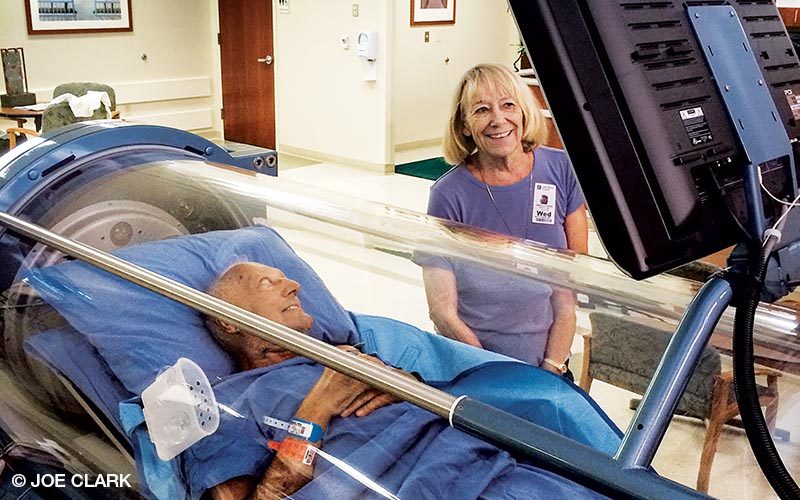As many health-care institutions face increasing pressure to control costs, the availability of hyperbaric chambers for dive emergencies has been greatly limited. Although there are approximately 1,375 hyperbaric chambers in the United States, only 130 accept patients on an emergency basis. In the U.S. there are only two chambers dedicated solely to divers; all others provide wound treatment.
With fewer hyperbaric facilities available for emergencies each year, those that are available have become overwhelmed by the burden of covering larger and larger geographic areas of responsibility. Emergency department physicians frequently contact DAN® to help them identify available chamber facilities to treat their most serious patients. It is not unusual to find that the closest facility cannot accept patients because the chamber is in use for another emergency treatment and unavailable, necessitating an expansion of the search range.

Compounding the problem is that some injured divers are turned away because of a misconception that divers need a level of care beyond what a facility can provide. In fact, divers are generally healthier and more stable than the average wound-care patient. Nor do injured divers need a chamber that can be pressurized to more than 2.8 ATA (60 feet of seawater), as is mistakenly believed by some health-care providers. The standard of care for the overwhelming majority of dive injuries is a U.S. Navy Treatment Table 6 (USN TT6). This treatment protocol does not exceed 2.8 ATA. Monoplace (single-occupant) chambers are capable of providing a USN TT6.
What Chambers Treat
The Undersea and Hyperbaric Medical Society (UHMS) has approved the following conditions for treatment with hyperbaric oxygen therapy (HBOT). Insurance companies will not typically cover the cost of HBOT for conditions not on this list.
Acute/urgent indications:
- crush injuries
- compromised grafts and flaps
- central retinal artery occlusion
- acute peripheral artery occlusion
- severe anemia
- decompression sickness
- air or gas embolism
- burns
- carbon-monoxide poisoning
- idiopathic sudden sensorineural hearing loss
- necrotizing fasciitis
- gas gangrene
- intracranial abscess
Nonacute indications:
- select problem wounds
- delayed effects of radiation therapy
- chronic osteomyelitis
How Chambers Get Funding
HBOT facilities most often treat nonacute indications. Because these indications are not as time-sensitive as the acute indications, patients can be scheduled and insurance coverage issues addressed in advance. These indications pay the bills of the hyperbaric centers, and payment for services is more predictable from these patients. Other factors beyond finances, however, affect a facility’s ability to be available 24/7.
As recently as 10 years ago the majority of hyperbaric centers were located in or attached to a hospital, which meant that most patients requiring HBOT were treated at the hospital. Income generated by treating the scheduled patients provided enough financial support to allow the hospital to offer after-hours emergency hyperbaric care. This also facilitated comprehensive treatment of emergency patients who required access to ancillary services such as critical care, vascular surgery, neurology and other specialties.
Reimbursement of chamber facilities’ costs by insurance companies and especially Medicare is the same whether the facility is available for emergencies or not. The costs of having staff on call 24/7/365 can be substantial. Accepting emergency and critical-care patients increases the potential liability risk to the facility and thus may increase liability insurance costs for the physician group and the hospital.
In recent years nonhospital-based clinics have dramatically increased, primarily due to an increase in the number of patients who can benefit from nonemergency HBOT. Patients in stable condition who require multiple scheduled treatments are likely to use facilities that are most convenient to them. This migration away from hospital-based chambers has reduced those chambers’ ability to absorb the additional costs incurred by accepting emergency patients.
Several years ago one hospital-based hyperbaric facility announced publicly that it was planning to end its emergency HBOT services. In an average year it treated 10-15 acute patients. Compensation for these treatments came nowhere close to offsetting the costs incurred by being available 24/7/365. This is a reality that many facilities face. In this case, local divers organized themselves and were able to persuade the hospital to continue emergency services.
DAN and UHMS
DAN continues to work with health-care professionals, including prehospital-care providers, to educate them about dive injuries and treatment. DAN also works continuously to stay up to date on each chamber’s operational status and willingness and ability to provide emergency care. The UHMS, which promotes dive and hyperbaric medicine, is trying to find a solution to the current state of affairs. Some in the field are working with the appropriate government agencies to address potential reimbursement incentives and remove obstacles to encourage more emergency facilities. One proposal currently under consideration is having similarly capable facilities in a given area provide emergency care on a rotating basis to avoid placing undue strain on a single facility.
What Divers Can Do
The dive community can influence the availability of chamber facilities for dive emergencies. First, divers should make certain they have insurance that covers HBOT, whether through their primary medical insurance or with specific coverage such as a DAN dive accident insurance policy. A community of insured divers means that facilities providing care are more likely to be paid (an important consideration for hospital administrators as they work to keep their hospital solvent) and thus less reticent to treat injured divers.
Divers can also use social and news media to bring attention to the situation. We should, as a community, emphasize that the need for emergency HBOT is not only for divers but also for the other potential acute/urgent indications for HBOT as well. Acknowledgement of the serious financial challenges facilities face should help foster productive dialogue among care providers and local communities of divers, and cooperation among interested parties offers the best opportunity for a solution.
© Alert Diver — Q4 Fall 2016
